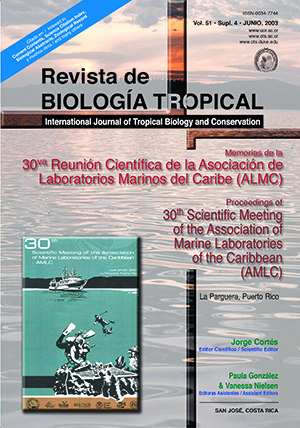Abstract
Epibiotic organisms inhabiting non-nesting hawksbill sea turtles, Eretmochelys imbricata (Linnaeus, 1766), are described from Mona and Monito Islands, Puerto Rico. Epibiont samples from 105 turtles of shallow (< 40 m) water foraging habitats were collected and identified to the lowest possible taxon. This epibiotic assemblage consisting of at least 4 algal functional groups and 12 animal phyla represents the greatest phylogenetic diversity for marine turtle epibiota. Six groups are considered new reports for marine turtles. Most epibiont colonization was found on posterior marginal scutes and under overlapping scutes. Ecological attributes of epibiota and their symbiosis with E. imbricata provide a tool to understand basi and epibiont populations.References
Caine, E.A. 1986. Carapace epibionts of nesting loggerhead sea turtles: Atlantic coast of USA. J. Exp. Mar. Biol. Ecol. 95: 15-26.
Cribb, A.V. 1969. Algae on a Hawk’s-Bill turtle. Queensland Naturalist 19: 108-109.
Díaz, M., J. Gutiérrez, D. Jasso, C. López, L. Sarti & C. Vallejo. 1992. Epibiontes y estado físico de las tortugas Lepidochelys olivacea y Dermochelys coriacea en el Playón de Mexiquillo, Michoacán, durante la temporada de anidación 1988-1989. Publ. Soc. Herpetol. Mex. 1: 19-25.
Dodd, I. 1988. Synopsis of the biological data on the loggerhead sea turtle Caretta caretta (Linnaeus 1758). FAO Synopsis NMFS-149. Fish and Wildlife Service U.S. Dept. Interior, Washington, DC. 54-60 p.
Eckert, K.L. & S.A. Eckert. 1988. Pre-reproductive movements of leatherback sea turtles (Dermochelys coriacea) nesting in the Caribbean. Copeia 2: 400-406.
Frazier, J., D. Margaritoulis, K. Muldoon, C.W. Potter, J. Rosewater, C. Ruckdeschel & S.
Salas. 1985. Epizoan communities on marine turtles. I Bivalve and Gastropod mollusks. Mar. Ecol. 6: 127-140.
Frazier, J., J.E. Winston & C.A. Ruckdeschel. 1992. Epizoan communities on marine turtles. III. Bryozoa. Bull. Mar. Sci. 51: 1-8.
Frick, M., K. Williams & M. Robinson. 1998. Epibionts associated with nesting loggerhead sea turtles (Caretta caretta) in Georgia. Herp. Rev. 29: 211-214.
Frick, M., K. Williams, D. Veljacic, L. Pierrard, J. Jackson & S. Knight. 2000. Newly documented epibiont species from nesting loggerhead sea turtles (Caretta caretta) in Georgia, USA. Mar. Turtle News 88: 3-5.
Gramentz, D. 1988. Prevalent epibiont sites on Caretta caretta in the Mediterranean Sea. Nat. Sci. 12: 33-46.
Green, D., 1998. Epizoites of Galapagos green turtles. In: Byles, R. and Y. Fernandez (compilers). Proceedings of the 16th Annual Symposium on Sea Turtle Biology and Conservation. NOAA Tech. Memo, NMFSSEFSC- 412, 158 p.
Márquez M. 1994. Sinopsis de datos biológicos sobre la tortuga lora Lepidochelys kempi (Garman, 1880). FAO Sinopsis sobre la pesca INP/S 152: 44-45.
Monroe, R. & C. Limpus. 1979. Barnacles on turtles in Queensland waters with descriptions of three new species. Mem. Qsld. Mus. 19: 197-223.
Sentíes, A., J. Espinoza-Avalos & J.C. Zurita. 1999. Epizoic algae of nesting sea turtles Caretta caretta (L.) and Chelonia mydas (L.) from the Mexican Caribbean. Bull. Mar. Sci. 64: 185-188.
Thomas, J.D. 1992. Podocerus chelonophilus a testudinous amphipod newly recorded from the western Atlantic Ocean. Bull. Mar. Sci. 50: 108-116.
Van Dam, R.P. & C.E. Diez. 1998. Home range of immature hawksbill turtles (Eretmochelys imbricata (Linnaeus) at two Caribbean Islands. J. Exp. Mar. Biol. Ecol. 220: 15-24.
##plugins.facebook.comentarios##

This work is licensed under a Creative Commons Attribution 4.0 International License.
Copyright (c) 2003 Revista de Biología Tropical


